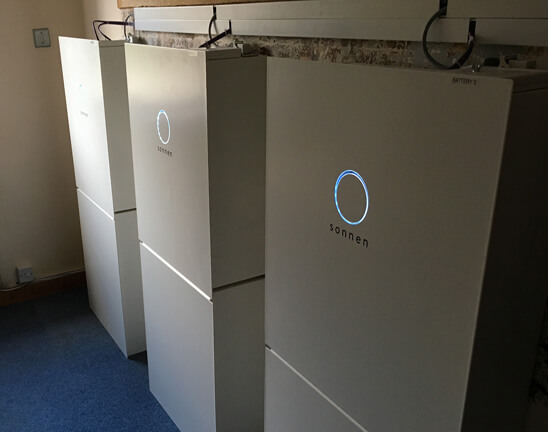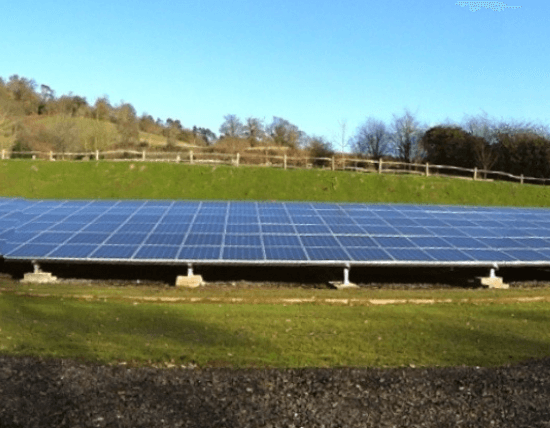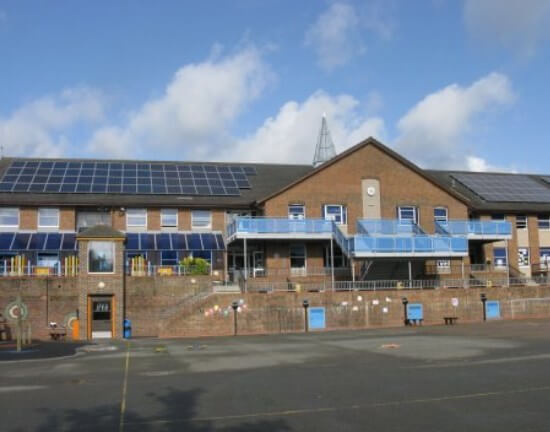St George’s College Iconic Solar Sports Hall
St George’s is an independent mixed Roman Catholic co-educational day school in Weybridge Surrey. The school have recently constructed a new Sports Hall for the school as their existing sports hall was only sized for 500 students (all boys). The new sport hall now caters for over 1000 pupils (both boys and girls) over a wide range of sporting activities.
The new hall is a flagship architectural building, designed by Scott Brown Rigg Architects, with many unique design features that required careful integration of the solar PV.
The structure of the building is made from curved glulam columns and roof beams, which support a plywood deck. Above the roof sites 150mm insulation, finished with a Sika Sarnafil single-ply roof membrane. The roof is curved in two directions much like the Olympic Park velodrome, and also features diamond-shaped roof ventilation towers.
Careful Integration of Solar
As such, the design needed to account for the following sensitivities:
- As a high-end architectural project, aesthetics were paramount to the client.
- The installation mounting system needed to work with the curved surface of the roof.
- We needed to avoid shade from the ventilation towers.
- The chosen system needed to be lightweight so as not to compress the insulation, or led to puddling of water
- The system needed to be non-penetrative
- We needed to install sufficient solar PV to meet overall building CO2 targets.
The building carbon targets implied the building had a target of 32kWp of solar PV to generate 29,688kWh of electricity per year. To meet this brief, we installed a system of 119 JA Solar 270W modules, connected to a single Solis 30kW inverter.
Sika SSM1 mounting system
Joju Solar are the solar energy partners of Sika Sarnafil who manufactured the roof membrane system. Working closely with them and the main roofing contractors, Malone Roofing, we designed and delivered what we to believe to be a prime example of sensitive architectural integration of a commercial solar PV roof.
The chosen mounting system was the Sika Solar Mount SSM1, which offers several unique features, ideal for this project. The mounting system consists of plastic triangular frames pitched at 15 degrees. These frames use rubber fixing flaps, that sit over the frames which are then rubber-welded directly to the roof membrane. Because the frames are bonded to the roof surface, the system is ballast-free, and therefore very lightweight. This not only simplifies construction but helps from a structural engineering point of view, especially in case such as this where the span of the roof is large. It also prevents compression of the insulation layer and puddling of water on the roof.
Uniquely, the mounting system and the roof membrane itself are covered under a single point warranty. As Sam Rogan, Sika Sarnafil Technical Advisor explains: “The SikaSolar system offers a low profile panel with high output, that is fully compatible with Sarnafil single ply roofing membranes”. This avoids any potential conflict between the multiple contractors on-site, as there is a single holder of risk and responsibility.
Primarily designed for flat roofs, the SSM1 is limited to being installed on roofs of less than a 10-degree pitch. We therefore restricted our array to those unshaded areas of the roof that met this design requirement. The area chosen was such that optimisers were not required and the system could be strung on a single 30kW inverter.
As a further step to enhance the aesthetics of the installation, the DC cable routes were laid in channels cut into the insulation membrane, which were then covered with the main roofing membrane. This removed the need for an unsightly cable tray running across the roof and preserved the clean aesthetics of the building.
(Images 1&3 courtesy of Scott Brown Rigg Architects)
Find Out More
- Our PV design team is on hand to help you realise the solar part of any new build project, large or small
- We have even integrated a bespoke solar PV array into the roof of Salisbury Cathedral
- Solar schools like St George’s are a speciality of ours – find out more about the hundreds of solar schools we’ve already built










